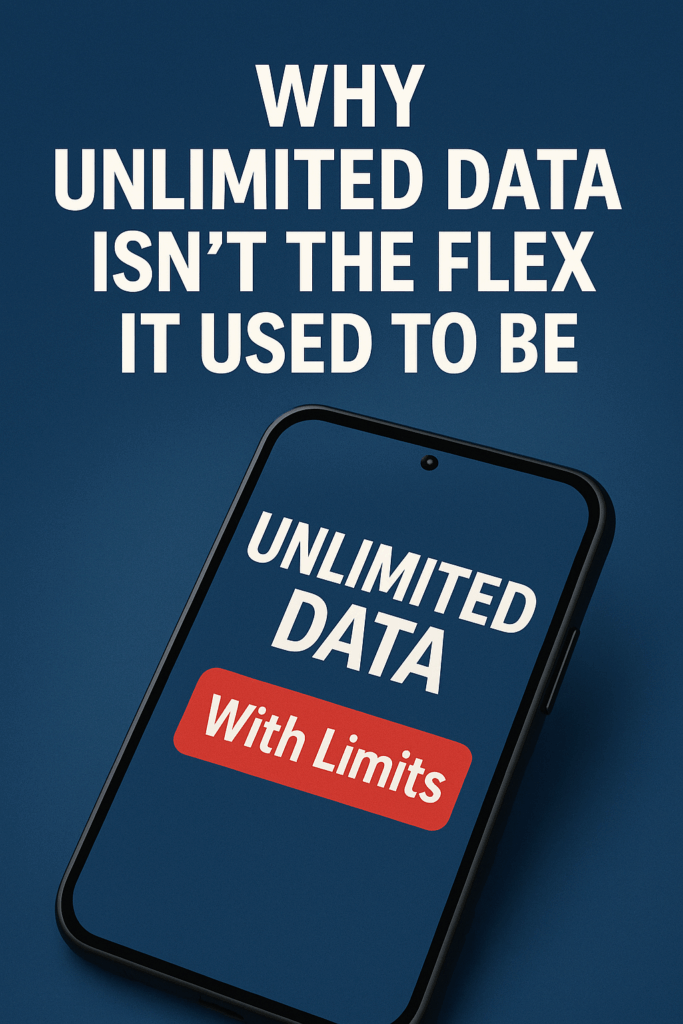

Prefer to listen instead?
Hear the full breakdown of how unlimited data evolved from a premium perk to a throttled norm. Brought to you by Pixlehale—tech, truth, and transparency, now in audio.
There was a time when having unlimited data on your phone meant something. It was a status symbol—reserved for early tech adopters or folks willing to shell out top dollar for constant access to the internet. Telling someone you had unlimited data used to carry the same weight as saying you had HBO in the early 2000s. But now? Everyone has it—or so they think.
A Brief History of the “Unlimited” Boom
Back in the late 2000s and early 2010s, mobile carriers like AT&T and Verizon started phasing out truly unlimited data plans. As smartphones exploded in popularity, data usage skyrocketed. Carriers, unprepared for the bandwidth demand, scrambled to protect their networks. Tiered plans were introduced, and unlimited data became a rare, expensive relic.
But then came the disruptors. Around 2013–2015, T-Mobile flipped the industry by reintroducing unlimited plans and aggressively marketing them as consumer-friendly. The “Uncarrier” strategy forced giants like Verizon and AT&T to bring unlimited plans back to the table. And they did—but with some fine print.
The Catch: Unlimited… With Limits
Today’s unlimited data plans are more marketing spin than pure generosity. Most plans come with data thresholds—hit that 50GB or 100GB mark, and your speeds may slow dramatically. This is called deprioritization, where your data takes a back seat during peak hours in congested areas.
Carriers also often throttle specific services like video streaming, capping them at 480p or 720p unless you pay extra. Hotspot usage is usually capped, too. So while the word “unlimited” suggests a blank check, what you’re really getting is a buffet with limits once you’ve had your third plate.
Why the Shift?
Advancements in network infrastructure—think the move from 3G to 4G LTE and now 5G—have made it significantly cheaper for carriers to deliver large amounts of data. And with more people using smartphones for everything from video calls to full-time remote work, “unlimited” became less of a perk and more of a necessity.
At the same time, competition between carriers drove prices down. Instead of fighting over minutes and texts, which are now basically free, the battleground became data. Unlimited plans became the norm not because carriers suddenly became generous, but because they had to keep up.
The Real Cost of Always Being Connected
The normalization of unlimited data has also changed how we live. We stream more, scroll more, and depend on our phones for everything. But it’s worth asking: what are we really paying for?
For many users, unlimited data offers peace of mind—no counting gigabytes or rationing Spotify. But the promise of “unlimited” has also been used to lure people into plans with hidden restrictions and upsells. It’s less about giving consumers more and more about finding clever ways to keep us plugged in while managing network loads behind the curtain.
Final Thought
Unlimited data today isn’t about flexing—it’s about fitting in. The phrase might still sound impressive, but the reality is a lot more complicated. So next time you see a commercial boasting about unlimited everything, just remember: there’s always a limit somewhere. Especially in the fine print.
Sources: Key data and statements in this article are drawn from The Verge, CNET, Wired, TechCrunch, T-Mobile, Verizon, and AT&T public statements. Additional insights were sourced from FCC reports and industry trend analyses. All assertions are supported by these reliable sources, ensuring a fact-based, well-rounded perspective throughout the article.